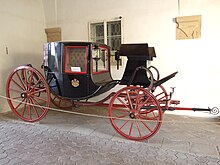Thechariotthat evolved from the ancientvehicleof this name (seeChariot) took on two main forms:
- A light, four-wheeled,horse-drawncarriagehaving a curved coach box with back seats only (a type ofcoupé), popular in the early 19th century.
- A vehicle for conveying persons especially in state, such as atriumphal caror a coach of state. This stately but manoeuvrable horse carriage was used for ceremonial occasions or for pleasure.


Acharioteewas a light, covered, four-wheeled pleasure carriage with two seats.[1]
Apost chariotwas a carriage for travelingpost.The term was used specifically for a kind of light four-wheeled carriage with a driver's seat in front.[2][3]
A vehicle such as acartorwagonfor transporting goods was also sometimes called achariot.
See also
editReferences
edit- ^Chariotee Clipart.Clipart ETC.
- ^The Casanova Tour - by Pablo Günther - The English Coupé or Post Chariot - Casanova Magazine.ArchivedFebruary 4, 2008, at theWayback MachineGiacomo Casanova - Reisewagen im 18. Jahrhundert (Travelling Carriages in the 18th century).
- ^98/43/1 Coach, horsedrawn, travelling chariot, coupe, timber/metal, used by Alexander Berry in Sydney, made by Thrupp, London, England, c.1850 - Powerhouse Museum Collection.Powerhouse Museum | Science + Design | Sydney Australia.